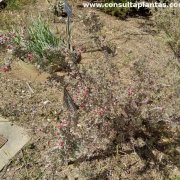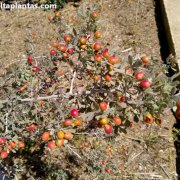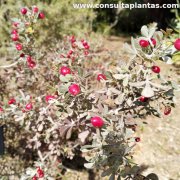Care of the shrub Searsia albida or Rhus albida |
|
The genus Searsia, family Anacardiaceae, comprises more than 100 species of shrubs and trees native to Africa and Asia. Some species are: Searsia albida, Searsia dentata, Searsia lucida, Searsia leptodictya, Searsia crenata, Searsia lancea, Searsia tomentosa. Scientific synonym: Rhus albida. This species is native to the Canary Islands and Morocco. They are very irregularly branched shrubs that reach 2.5 meters (8.2 feet) in height. The trifoliate leaves are whitish gray; they can lose their leaves in case of prolonged drought. The yellowish flowers are small and have no decorative interest. They bloom in the fall. The red or orange fruits are quite decorative because they contrast with the color of the leaves. Rhus albida can be used in rockeries, on dry and sunny slopes and as isolated specimens. Searsia albida needs full sun exposure and a warm climate. It resists occasional frosts down to -2 ºC (28.4 ºF). Rhus albida prefers sandy or stony soil; the most important thing is that the drainage is excellent. Searsia albida is a very resistant to drought plant that needs moderate irrigation waiting for the substrate to dry completely. Rhus albida does not need fertilizer. Searsia albida can be lightly pruned in late winter to maintain a compact habit. Rhus albida is a plant resistant to the usual pests and diseases but sensitive to excess watering. Searsia albida is propagated from seed sown in the nursery in spring. |
Images of the shrub Searsia albida or Rhus albida |
Find plants
Searsia albida or Rhus albida | Care and Growing
© 2025 FavThemes


